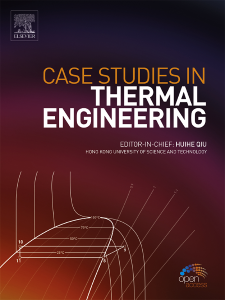含 h-BN 和 MPCM 不同填料的灌封胶的机械和热性能研究
IF 6.4
2区 工程技术
Q1 THERMODYNAMICS
引用次数: 0
摘要
利用封装材料降低接触热阻已成为解决电子元件散热能力不足问题的一种可行方法。这项研究的目的是利用相变微胶囊(MPCM)和六方氮化硼纳米粉体(h-BN)作为导热填料,优化灌封胶的机械和热力学性能。实验结果表明,h-BN 对灌封胶的拉伸强度有积极影响,当质量分数为 30% 时,拉伸强度提高了 7.1%。然而,添加 MPCM 会削弱灌封胶的抗拉强度。添加 MPCM 和 h-BN 都能有效改善灌封胶的导热性能:当填料质量分数低于 20 % 时,添加 MPCM 填料的灌封胶比添加 h-BN 的灌封胶具有更强的增强能力;而随着填料质量分数的不断增加,添加 h-BN 填料的灌封胶的导热性能更好。灌封胶的热缓冲能力随 MPCM 质量分数的增加而显著提高,而 h-BN 对热缓冲能力的影响并不明显。此外,添加 h-BN 和 MPCM 还能明显改善灌封胶的温度均匀性。本文章由计算机程序翻译,如有差异,请以英文原文为准。
Research on the mechanical and thermal properties of potting adhesive with different fillers of h-BN and MPCM
Using packaging materials to reduce contact thermal resistance has become a promising method to solve the problem of insufficient heat dissipation capacity of electronic components. The purpose of this work is to optimize the mechanical and thermodynamic performance of potting adhesive using phase change microcapsules (MPCM) and hexagonal boron nitride nano-powder (h-BN) as thermal conductive fillers. The experimental results indicated that h-BN has a positive effect on the tensile strength of the potting adhesive, with a 7.1 % increase in tensile strength at a mass fraction of 30 %. However, the addition of MPCM will weaken the tensile strength of the potting adhesive. Adding MPCM and h-BN can both effectively improve the thermal conductivity of the potting adhesive: when the filler mass fraction is lower than 20 %, the potting adhesive with MPCM filler exhibits more strengthening capability than h-BN type; while with the continuous increase of filler mass fraction, the thermal conductivity of the potting adhesive with h-BN filler is better. The thermal buffering capacity of the potting adhesive significantly increases with the mass fraction of MPCM, while the effect of h-BN on thermal buffering capacity is not significant. In addition, the addition of h-BN and MPCM significantly improves the temperature uniformity of the potting adhesive.
求助全文
通过发布文献求助,成功后即可免费获取论文全文。
去求助
来源期刊

Case Studies in Thermal Engineering
Chemical Engineering-Fluid Flow and Transfer Processes
CiteScore
8.60
自引率
11.80%
发文量
812
审稿时长
76 days
期刊介绍:
Case Studies in Thermal Engineering provides a forum for the rapid publication of short, structured Case Studies in Thermal Engineering and related Short Communications. It provides an essential compendium of case studies for researchers and practitioners in the field of thermal engineering and others who are interested in aspects of thermal engineering cases that could affect other engineering processes. The journal not only publishes new and novel case studies, but also provides a forum for the publication of high quality descriptions of classic thermal engineering problems. The scope of the journal includes case studies of thermal engineering problems in components, devices and systems using existing experimental and numerical techniques in the areas of mechanical, aerospace, chemical, medical, thermal management for electronics, heat exchangers, regeneration, solar thermal energy, thermal storage, building energy conservation, and power generation. Case studies of thermal problems in other areas will also be considered.
 求助内容:
求助内容: 应助结果提醒方式:
应助结果提醒方式:


